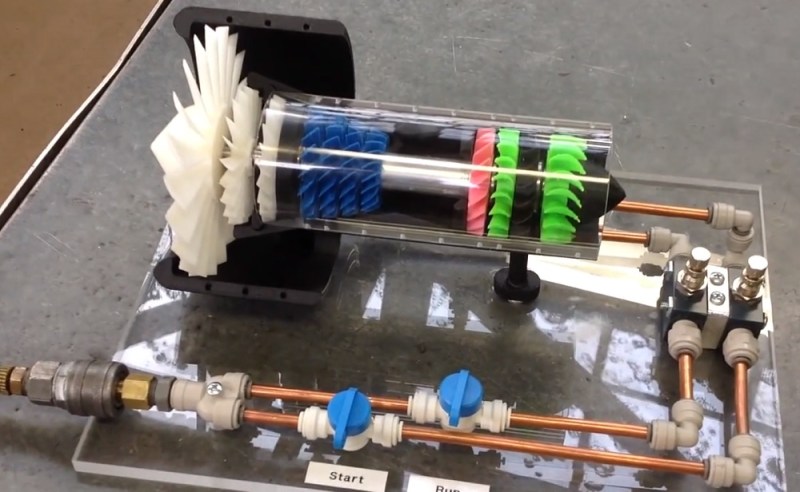Thanks to the wonders of 3D printing, you can now have a 3D printed a jet engine of your very own. Unlike jet engines we’ve seen before, this one comes with no chance of the operator getting burned to a crisp. [Gerry] is a self-proclaimed “broken down motor mechanic” from New Zealand. He’s designed a rather awesome jet engine in 3D Software, and printed it on his UP Plus printer. The engine itself is a cutaway model of a high-bypass turbofan engine. While we’re not sure which make and model of jet engine this cutaway represents, we’re still very impressed.
This isn’t just a static display model – the engine will actually spin up with the help of compressed air. Separate start and run tubes send air to the turbine and main fain respectively. It even has that distinctive turbofan “buzz saw” sound. While this model is relatively safe, [Gerry] does warn to keep the pressure down, or it could come apart. To that end we’d recommend adding a regulator before the quick disconnect.
The Thingiverse project is a bit light on instructions. However this situation is remedied by [hacksaw], who posted a pictorial and build log up on pp3d. [Hacksaw] did run into a few problems with the build, but nothing a little bit of superglue couldn’t fix. It may have fewer moving parts, but this definitely puts our old Visible V8 Engine kit to shame.
[Via Adafruit]
















just AMAZING!!
I want to make this in a bad way. I can print the plastic parts, but can’t justify buying all of the other stuff.
ditto
is this a re-fry HAD post, seriously having a deja vue moment here.
not trying to troll but what differs this from a turbine?
You’re right BiOzZ, this isn’t close to being an engine. It’s a very cool demonstration of how an engine looks inside, but ultimately it’s just a turbine.
neat
Next level: cast alloy parts. And a tachometer. PSI or airflow readings would be good, too.
Also, get some incense sticks and let the smoke go through the innards.
Missing many stages of stators.AgentJayZ on YouTube will fill you in on why these are important.
To the people who think it’s “just a turbine”. No, it’s not.
Only the 4 blades on the exhaust (right side) are the turbine. The blades on the left (white and blue) are the compressor part of the engine. The first blade (from the left) is partly compressor and partly “ducted fan”.
On first sight this looks cool but for a lot of people who have more than a basic education it’s more misleading than educational.
The turbine part (with pink, , green, black blades) at least looks kinda ok, but the compressor part (white and blue blades) makes it look very silly because they just do not work at all because the direction of the flow is not redirected in each set of blades.
The maker of this contraption clearly put some time/effort/money into making this, and I’m flabbergasted as to why he / she didn’t put in the little bit of extra effort to at least make it look like a real engine.
After seeing the first part of his youtube video I’m unfortunately convinced he/she hardly even understands the basics of jet engines. and this is of course the reasen the whole thing blows apart if you put more than a little bit of compressed air inside. If the design came even close to a real engine it would very likely produce so much trhrust that it would never reach enough rpm to blow itself apart.
He also tried to imitate a more complex design than the single shaft engine I first thought he did. Unfortunately this makes the flaws in this design only worse. I culsdn’t watch the video to the end.
“Excuse me stewardess, the planes engines look like they’re made of plastic.”, “Why yes sir, they are.”, “Ah, which way to the exit?” Nice table top display.